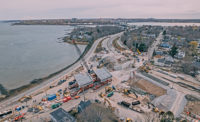While newspapers across the country are looking for ways to cut costs or change operations, TPC Holdings of Lewiston, Idaho, has invested $12 million in a state-of-the-art press and a new two-story, 32,000-sq-ft building adjacent to their business office to house it.
The Lewiston Tribune and Moscow Pullman Daily News are now being printed on a huge MAN Roland Uniset 75 offset press, providing daily newspapers for more than 32,000 subscribers in north-central Idaho and southeastern Washington.
The Tribune was first published in 1892 by two brothers, Albert H. and Eugene L. Alford, the first of four generations of Alfords to publish the paper. The first issues were printed on a four-page Washington Press.
A new building was built in 1902 and it would be the paper’s home for the next 59 years. In 1926, a 16-page Duplex press was purchased and used until 1961 when a Goss Unitube letterpress was put into service. In 1978 the printing facility was expanded to provide needed space for a new Goss Urbanite offset press that was in service for 31 years until the arrival of the MAN Roland press in 2008.
A.L. (Butch) Alford is the president of TPC Holdings and a former editor and publisher of the Tribune. He says that from the beginning, the paper has always looked to keep pace with technology. “To meet our customers’ needs in these tough economic times, we decided to make an investment in a new production center and press,” Alford says.
Wayne Hollingshead is the Tribune’s general manager. He says that inside the 188-ft-long press hall, there is a 4.5-ft thick, reinforced concrete-block foundation that supports the 106-ft-long press. Each of the eight press components weighs 20 tons. The press is 30 ft tall and 20 ft wide.
“Some presses are low slung while this one is taller, so the architects designed the building to fit the press and allow for expansion later,” says Alford. “We didn’t want to be in the position in the future where we would have to leave the downtown core of the city,” he says.
According to Reese Hewett, president of Kenaston Construction of Lewiston, the general contractor on the project, one of the biggest challenges was laying the press pad.
“The concrete foundation runs the full length of the press with various pits and recesses. We used laser technology to ensure a level base for the press,” he says.
The initial phase of construction called for building three walls and a roof with a roll-up door as a temporary fourth wall. Hewett says that once the foundation was poured, MAN Roland came in with a crew from Germany with all the heavy press parts and assembled the press, working their way north to south.
After the press was installed, Kenaston workers removed the temporary roll-up door and erected a glass-front wall.
“It was a highly coordinated effort to schedule the press assembly then have our construction crew wrap up the building and make it weather tight,” Hewett says.
Michell Radamaker is the project manager for Don Botts Associate Architects of Lewiston. She said the firm had never tackled this kind of project before. “One of the larger challenges was the coordination with the MAN Roland technicians. They came to the table with precise design parameters that had to be met,” she says.
“From the architectural aspects, we wanted the new building to mesh with the existing structure, so we came up with some building details that tied the two together. We tried to incorporate some art-deco aspects of the original building with the new facility,” Radamaker says.
“We also wanted to show off the press itself because it is such an interesting piece of equipment, so we designed a great big window in the front of the building so you can see the press from the street. It also provides a lot of natural light, creating a nice work space inside the building,” she says.
The main entryway is set up to be a museum with old photos and printing equipment on display. It shows the history of the Tribune and the four generations of Alfords that have run the paper.


























Post a comment to this article
Report Abusive Comment